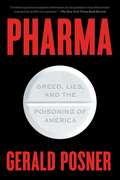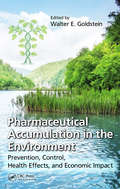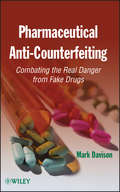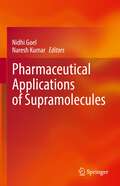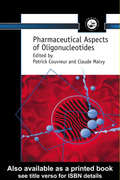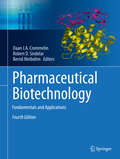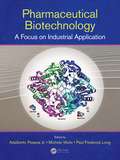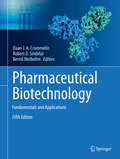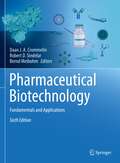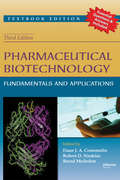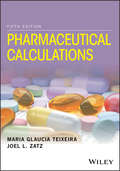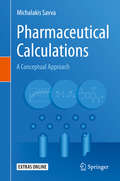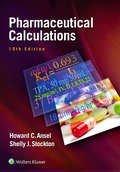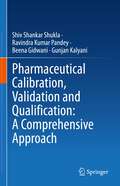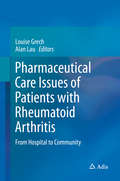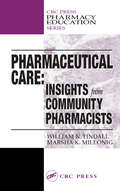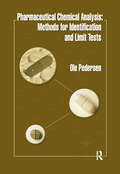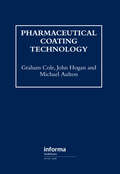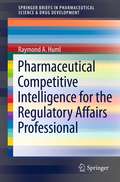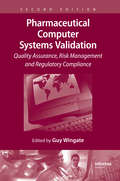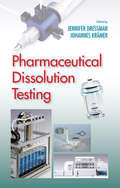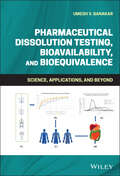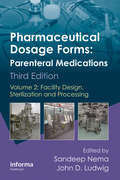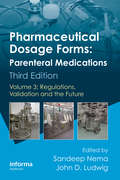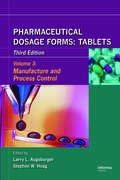- Table View
- List View
Pharma: Greed, Lies, and the Poisoning of America
by Gerald PosnerAward-winning journalist and New York Times bestselling author Gerald Posner traces the heroes and villains of the trillion-dollar-a-year pharmaceutical industry and uncovers how those once entrusted with improving life have often betrayed that ideal to corruption and reckless profiteering—with deadly consequences. Pharmaceutical breakthroughs such as antibiotics and vaccines rank among some of the greatest advancements in human history. Yet exorbitant prices for life-saving drugs, safety recalls affecting tens of millions of Americans, and soaring rates of addiction and overdose on prescription opioids have caused many to lose faith in drug companies. Now, Americans are demanding a national reckoning with a monolithic industry. Pharma introduces brilliant scientists, in-corruptible government regulators, and brave whistleblowers facing off against company executives often blinded by greed. A business that profits from treating ills can create far deadlier problems than it cures. Addictive products are part of the industry&’s DNA, from the days when corner drugstores sold morphine, heroin, and cocaine, to the past two decades of dangerously overprescribed opioids. Pharma also uncovers the real story of the Sacklers, the family that became one of America&’s wealthiest from the success of OxyContin, their blockbuster narcotic painkiller at the center of the opioid crisis. Relying on thousands of pages of government and corporate archives, dozens of hours of interviews with insiders, and previously classified FBI files, Posner exposes the secrets of the Sacklers&’ rise to power—revelations that have long been buried under a byzantine web of interlocking companies with ever-changing names and hidden owners. The unexpected twists and turns of the Sackler family saga are told against the startling chronicle of a powerful industry that sits at the intersection of public health and profits. Pharma reveals how and why American drug companies have put earnings ahead of patients.
Pharmaceutical Accumulation in the Environment: Prevention, Control, Health Effects, and Economic Impact
by Walter E. GoldsteinA Proactive Approach to Improving and Protecting the EnvironmentThe accumulation of pharmaceuticals in the environment is a growing concern, the magnitude of which has not been determined, yet cannot be ignored. Touting the benefits of research and discovery as it relates to a pharmaceutical presence in the environment, Pharmaceutical Accumulation
Pharmaceutical Anti-Counterfeiting: Combating the Real Danger from Fake Drugs
by Mark DavisonThis book overviews and integrates the business and technical issues that pharmaceutical companies need to know in order to combat the major global problem of counterfeit medicines. In addition to discussion of the problems, the author Davison addresses analytical techniques scientists use to detect counterfeits and presents some possible solutions to the threat of counterfeit medical products. Coverage moves from basic overview of the problem, costs / risks to consumers (toxic products, mistrust of drug companies) and business (revenue loss, public trust), government oversight and regulation, authentication strategies (packaging, analytical techniques), product tracking and supply chain, and case studies from around the globe.
Pharmaceutical Applications of Supramolecules
by Naresh Kumar Nidhi GoelThis book outlines the use of supramolecules as different pharmaceutical drugs. Supramolecular chemistry in pharmaceutical sciences is quite a young and rapidly developing field. Supramolecular assemblies might offer an alternative for existing pharmaceutical formulations, as they facilitate the improvement of physicochemical and pharmacological properties i.e., higher bioavailability, better biocompatibility and drug-targeting, fewer multidrug-resistances. This book offers an overview of the recent advances in supramolecular structures and discusses the future aspects and challenges related to the development of these molecules, providing also a perspective on how to overcome these issues. Divided into 13 chapters contributed by experts in their field, the book provides a deeper understanding of intermolecular forces playing pivotal roles in mediating the interactions between chemical molecules and biological systems by focusing on different applications of supramolecular compounds. In this book, readers will find valuable insights into the preparation of supramolecules and the latest research and development trends of supramolecules as anticancer drugs, including liquid-crystalline supramolecular assemblies, and as antimicrobial, antiviral, anti-inflammatory and cardiovascular drugs. Particular attention is given to the application of supramolecules in the fields of biomedicine, bioimaging, and vaccine development. Given its breadth, this book will appeal to a wide readership from researchers and students interested in these fields to professionals in the pharma industry.
Pharmaceutical Aspects of Oligonucleotides
by Patrick CouvreurOligonucleotides diffuse poorly through biological barriers, including cell membranes. They are also rapidly degraded in vivo by nucleuses. Aiming to improve the administration of compounds, the book studies the development of nucleotide chemistry.
Pharmaceutical Biotechnology
by Bernd Meibohm Daan J. A. Crommelin Robert D. SindelarThis introductory text explains both the basic science and the applications of biotechnology-derived pharmaceuticals, with special emphasis on their clinical use. It serves as a complete one-stop source for undergraduate/graduate pharmacists, pharmaceutical science students, and for those in the pharmaceutical industry The Fourth Edition will completely update the previous edition, and will also include additional coverage on the newer approaches such as oligonucleotides, siRNA, gene therapy and nanotech.
Pharmaceutical Biotechnology: A Focus on Industrial Application
by Paul Frederick Long Adalberto Pessoa Jr., Michele VitoloPharmaceutical Biotechnology: A Focus on Industrial Application covers the development of new biopharmaceuticals as well as the improvement of those being produced. The main purpose is to provide background and concepts related to pharmaceutical biotechnology, together with an industrial perspective. This is a comprehensive text for undergraduates, graduates and academics in biochemistry, pharmacology and biopharmaceutics, as well as professionals working on the interdisciplinary field of pharmaceutical biotechnology. Written with educators in mind, this book provides teachers with background material to enhance their classes and offers students and other readers an easy-to-read text that examines the step-by-step stages of the development of new biopharmaceuticals. Features: Discusses specific points of great current relevance in relation to new processes as well as traditional processes Addresses the main unitary operations used in the biopharmaceutical industry such as upstream and downstream Includes chapters that allow a broad evaluation of the production process Dr. Adalberto Pessoa Jr. is Full Professor at the School of Pharmaceutical Sciences of the University of São Paulo and Visiting Senior Professor at King’s College London. He has experience in enzyme and fermentation technology and in the purification processes of biotechnological products such as liquid–liquid extraction, cross-flow filtration and chromatography of interest to the pharmaceutical and food industries. Dr. Michele Vitolo is Full Professor at the School of Pharmaceutical Sciences of the University of São Paulo. He has experience in enzyme technology, in immobilization techniques (aiming the reuse of the biocatalyst) and in the operation of membrane reactors for obtaining biotechnological products of interest to the pharmaceutical, chemical and food industries. Dr. Paul F. Long is Professor of Biotechnology at King's College London and Visiting International Research Professor at the University of São Paulo. He is a microbiologist by training and his research uses a combination of bioinformatics, laboratory and field studies to discover new medicines from nature, particularly from the marine environment.
Pharmaceutical Biotechnology: Fundamentals And Applications (Pharmaceutical Biotechnology Ser. #7)
by Bernd Meibohm Daan J. A. Crommelin Robert D. SindelarThis introductory text explains both the basic science and the applications of biotechnology-derived pharmaceuticals, with special emphasis on their clinical use. It serves as a complete one-stop source for undergraduate/graduate pharmacists, pharmaceutical science students, and for those in the pharmaceutical industry. The Fifth Edition completely updates the previous edition, and also includes additional coverage on the newer approaches such as oligonucleotides, siRNA, gene therapy and nanotech and enzyme replacement therapy.
Pharmaceutical Biotechnology: Fundamentals and Applications
by Bernd Meibohm Daan J. A. Crommelin Robert D. SindelarThis introductory text explains both the basic science, production, quality, dosage forms, administration, economic and regulatory aspects and the clinical applications of biotechnology-derived pharmaceuticals. It serves as a complete one-stop source for undergraduate/graduate pharmacists and pharmaceutical science students. An additional important audience are pharmaceutical scientists in industry and academia, particularly those who have not received formal training in pharmaceutical biotechnology and are inexperienced in this field. The rapid growth and advances in the field made it necessary to revise this textbook in order to continue providing up-to-date information and introduce readers to cutting edge knowledge and technology of this field. This Sixth Edition completely updates the previous edition and includes additional coverage on new approaches such as oligonucleotides, siRNA, mRNA, gene therapy, cell therapies, monoclonal antibodies and vaccines. With more than 3-million-chapter downloads, the fifth edition of the textbook has achieved widespread distribution as a key educational resource for the field of pharmaceutical biotechnology.
Pharmaceutical Biotechnology: Fundamentals and Applications, Third Edition
by Bernd Meibohm Daan J. A. Crommelin Robert D. SindelarCompletely revised text that reflects to emergent trends and cutting-edge advances in pharmaceutical biotechnology, this Third Edition provides a well-balanced framework for understanding every major aspect of pharmaceutical biotechnology, including drug development, production, dosage forms, administration, and therapeutic developments. New chapte
Pharmaceutical Calculations
by Maria Glaucia Teixeira Joel L. ZatzPharmacists are required to make certain kinds of calculations that determine the quantities of materials required for filling prescriptions and making up formulas. The new and expanded topics introduced in the fourth edition teach pharmacists and pharmacy students how to do the calculations required in current practice, covering important areas such as handling injectibles, including those used in parenteral nutrition and radiopharmaceuticals.The book also includes new chapters on isotonicity, intravenous fluids, and nutritional calculations.Features:* New concepts introduced in sequence, encouraging the student to master each concept before moving ahead* Many examples and practice problems, all with answers and the availability of rapid feedback build confidence* Filled with practical instruction relevant to the problems pharmacist face in their practice
Pharmaceutical Calculations: A Conceptual Approach
by Michalakis SavvaPharmaceutical Calculations: A Conceptual Approach, is a book that combines conceptual and procedural understanding for students and will guide you to master prerequisite skills to carry out accurate compounding and dosage regimen calculations. It is a book that makes the connection between basic sciences and pharmacy. It describes the most important concepts in pharmaceutical sciences thoroughly, accurately and consistently through various commentaries and activities to make you a scientific thinker, and to help you succeed in college and licensure exams. Calculation of the error associated with a dose measurement can only be carried out after understanding the concept of accuracy versus precision in a measurement. Similarly, full appreciation of drug absorption and distribution to tissues can only come about after understanding the process of transmembrane passive diffusion. Early understanding of these concepts will allow reinforcement and deeper comprehension of other related concepts taught in other courses.More weight is placed on the qualitative understanding of fundamental concepts, like tonicity vs osmotic pressure, diffusion vs osmosis, crystalloids vs colloids, osmotic diuretics vs plasma expanders, rate of change vs rate constants, drug accumulation vs drug fluctuation, loading dose vs maintenance dose, body surface area (BSA) vs body weight (BW) as methods to adjust dosages, and much more, before considering other quantitative problems. In one more significant innovation, the origin and physical significance of all final forms of critical equations is always described in detail, thus, allowing recognition of the real application and limitations of an equation. Specific strategies are explained step-by-step in more than 100 practice examples taken from the fields of compounding pharmacy, pharmaceutics, pharmacokinetics, pharmacology and medicine.
Pharmaceutical Calculations: The Pharmacist's Handbook
by Howard C. Ansel Shelly StocktonMaster the fundamental calculations principles and basic techniques you need to know for successful pharmacy practice! Thoroughly reviewed by practitioners, and educators, this 15th Edition maintains high standards for both academic and basic practice requirements, while offering the most comprehensive and in-depth coverage of pharmacy calculations available. A consistent, step-by-step approach makes it easy to work through the problems and gain a greater understanding of the underlying concepts.
Pharmaceutical Calibration, Validation and Qualification: A Comprehensive Approach
by Shiv Shankar Shukla Ravindra Kumar Pandey Gunjan Kalyani Beena GidwaniThis up-to-date and unique monograph covers the different aspects of pharmaceutical validation, calibration, qualification and documentation. It discusses the various methods and processes under all these heads. It includes eight major sections and exhaustively covers each topic.The book includes interesting and timely topics like the ‘Validation of herbals’ considering the increasing reliance on herbal medicines. It includes a section of validation of dosage forms, which is an essential topic for any pharmaceutical scientist. The chapters provide lucid illustrations, figures, flowcharts and other diagrams to facilitate understanding. A final section on 'expert opinion' provides a rundown about the global scenario to the readers. The book serves as a complete reference material for students, researchers and industry experts in the field of pharmaceutical sciences, medicinal chemistry and pharmacology.
Pharmaceutical Care Issues of Patients with Rheumatoid Arthritis
by Louise Grech Alan LauThis book presents concise, comprehensive summaries of topics necessary to understand rheumatoid arthritis (RA) management, aligned with patient needs, as a reference suitable for practitioners and students of all levels. Special attention is paid to the innovative RhMAT (Rheumatoid Arthritis Medication Assessment Tool), in addition to descriptions of the pharmacological management of RA, pharmacoeconomic and pharmacovigilance considerations, the benefits of seamless care, and case presentations. Rheumatoid arthritis is one of the most common forms of inflammatory arthritis in the world, with a prevalence of 0. 5 to 1%. While no cure has yet been established, modern biotechnology has enabled highly effective management, if treatment begins early. However, cost and side effects, such as immune suppression, continue to present barriers, and monitoring of patients is pivotal to safe and effective disease management. Both hospital and community pharmacists are involved in RA patient management, and have responsibilities to this patient population. Identifying pharmaceutical care issues and ensuring that the patients are managed in accordance to best evidence-based medicine are paramount. Best care is delivered when pharmacists effectively communicate with each other, the prescribers and the multidisciplinary team members involved in the care of the patient. This book aims to tackle the various aspects of the management of RA patients across all the settings.
Pharmaceutical Care: INSIGHTS from COMMUNITY PHARMACISTS (Pharmacy Education Series)
by William N. Tindall Marsha K. MillonigPharmacy is the nation's third largest health profession, with nearly 200,000 licensed pharmacists in the United States and 125,000 practicing in community pharmacies. It is in community settings where pharmaceutical care will be judged, accepted, and ultimately paid for. Pharmaceutical Care: Insights from Community Pharmacists introduces the conce
Pharmaceutical Chemical Analysis: Methods for Identification and Limit Tests
by Ole PedersenComplete, referenced information in an easy-to-use formatMany of the monographs in the European Pharmacopiea, the industry standard test for certain groups of ingredients and excipients, do not describe the tests in full, but reference general methods based on test-tube chemistry. When a test fails, you need to know what went wrong, how it can be f
Pharmaceutical Coating Technology
by Graham Cole John Hogan Michael AultonThis book is the definitive work on the theory and practice of pharmaceutical tablet and pellet coating. It describes both the practical and theoretical aspects of tablet coating, including the equipment and methods used in laboratory development, scale-up and production systems, More...as well as automation and validation. This book also discusses
Pharmaceutical Competitive Intelligence for the Regulatory Affairs Professional
by Raymond A. HumlThis Brief defines competitive intelligence (CI) as a tool for making investment decisions within the pharmaceutical industry. It provides an overview of processes that the regulatory affairs professional must take into account when evaluating data impacting product-based risk evaluations. These apply particularly to evaluations that focus on outputs such as regulatory approval, or the commercial impact of product labeling on the sales forecast over a limited timeframe. The Brief also provides an overview of intellectual property assessment that can impact a product's lifespan on the market due to patent protection itself (or loss of patent protection) or via regulatory exclusivity. Case examples are discussed to illustrate the importance of keeping up with the ever-changing regulations, and how to interpret them in the context of CI. In addition, there is a section on virtual data rooms (VDRs) which currently function as the cornerstone of due diligence investigations. While aimed primarily at regulatory affairs professionals in the United States, this publication provides a useful adjunct for other pharmaceutical executives, especially those new to product-based investments, and regulatory affairs professionals in other regions.
Pharmaceutical Computer Systems Validation: Quality Assurance, Risk Management and Regulatory Compliance
by Guy WingateThoroughly revised to include the latest industry developments, the Second Edition presents a comprehensive overview of computer validation and verification principles and how to put them into practice. To provide the current best practice and guidance on identifying and implementing improvements for computer systems, the text extensively reviews regulations of pharmaceuticals, healthcare products, blood processing, medical devices, clinical systems, and biotechnology. Ensuring that organizations transition smoothly to the new system, this guide explains how to implement the new GMP paradigm while maintaining continuity with current practices. In addition, all 24 case studies from the previous edition have been revised to reflect the new system.
Pharmaceutical Dissolution Testing
by Johannes Krämer Jennifer DressmanAn expertly written source on the devices, systems, and technologies used in the dissolution testing of oral pharmaceutical dosage forms, this reference provides reader-friendly chapters on currently utilized equipment, equipment qualification, consideration of the gastrointestinal physiology in test design, the analysis and interpretation of data
Pharmaceutical Dissolution Testing, Bioavailability, and Bioequivalence: Science, Applications, and Beyond
by Umesh V. BanakarExplore the cutting-edge of dissolution testing in an authoritative, one-stop resource In Pharmaceutical Dissolution Testing, Bioavailability, and Bioequivalence: Science, Applications, and Beyond, distinguished pharmaceutical advisor and consultant Dr. Umesh Banakar delivers a comprehensive and up-to-date reference covering the established and emerging roles of dissolution testing in pharmaceutical drug development. After discussing the fundamentals of the subject, the included resources go on to explore common testing practices and methods, along with their associated challenges and issues, in the drug development life cycle. Over 19 chapters and 1100 references allow practicing scientists to fully understand the role of dissolution, apart from mere quality control. Readers will discover a wide range of topics, including automation, generic and biosimilar drug development, patents, and clinical safety. This volume offers a one-stop resource for information otherwise scattered amongst several different regulatory regimes. It also includes: A thorough introduction to the fundamentals and essential applications of pharmaceutical dissolution testing Comprehensive explorations of the foundations and drug development applications of bioavailability and bioequivalence Practical discussions about solubility, dissolution, permeability, and classification systems in drug development In-depth examinations of the mechanics of dissolution, including mathematical models and simulations An elaborate assessment of biophysiologically relevant dissolution testing and IVIVCs, and their unique applications A complete understanding of the methods, requirements, and global regulatory expectations pertaining to dissolution testing of generic drug products Ideal for drug product development and formulation scientists, quality control and assurance professionals, and regulators, Pharmaceutical Dissolution Testing, Bioavailability, and Bioequivalence is also the perfect resource for intellectual property assessors.
Pharmaceutical Dosage Forms - Parenteral Medications: Volume 2: Facility Design, Sterilization and Processing
by Sandeep Nema John D. LudwigThis three-volume set of Pharmaceutical Dosage Forms: Parenteral Medications is an authoritative, comprehensive reference work on the formulation and manufacture of parenteral dosage forms, effectively balancing theoretical considerations with the practical aspects of their development. As such, it is recommended for scientists and engineers in the
Pharmaceutical Dosage Forms - Parenteral Medications: Volume 3: Regulations, Validation and the Future
by Sandeep Nema John D. LudwigThis three-volume set of Pharmaceutical Dosage Forms: Parenteral Medications is an authoritative, comprehensive reference work on the formulation and manufacture of parenteral dosage forms, effectively balancing theoretical considerations with the practical aspects of their development. As such, it is recommended for scientists and engineers in the
Pharmaceutical Dosage Forms - Tablets: Manufacture and Process Control
by Larry L. Augsburger Stephen W. HoagThe ultimate goal of drug product development is to design a system that maximizes the therapeutic potential of the drug substance and facilitates its access to patients. Pharmaceutical Dosage Forms: Tablets, Third Edition is a comprehensive treatment of the design, formulation, manufacture, and evaluation of the tablet dosage form. With over 700 i
